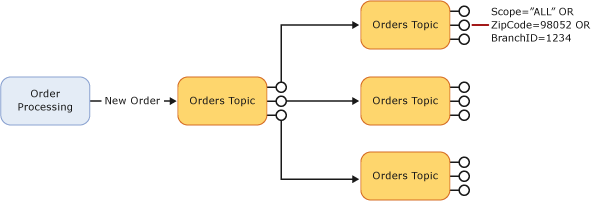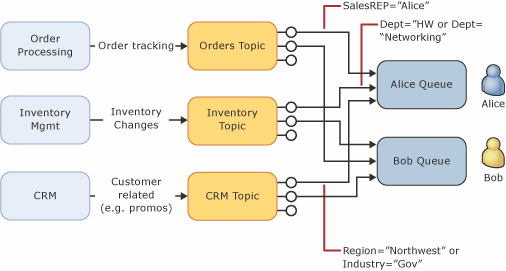Chaining Service Bus entities with autoforwarding
The Service Bus autoforwarding feature enables you to chain a queue or subscription to another queue or topic that is part of the same namespace. When autoforwarding is enabled, Service Bus automatically removes messages that are placed in the first queue or subscription (source) and puts them in the second queue or topic (destination). It's still possible to send a message to the destination entity directly.
Note
The basic tier of Service Bus doesn't support the autoforwarding feature. For differences between tiers, see Service Bus pricing.
The destination entity must exist at the time the source entity is created. If the destination entity doesn't exist, Service Bus returns an exception when asked to create the source entity.
Scenarios
Scale out an individual topic
You can use autoforwarding to scale out an individual topic. Service Bus limits the number of subscriptions on a given topic to 2,000. You can accommodate more subscriptions by creating second-level topics. Even if you aren't bound by the Service Bus limitation on the number of subscriptions, adding a second level of topics can improve the overall throughput of your topic.

Decouple message senders from receivers
You can also use autoforwarding to decouple message senders from receivers. For example, consider an Enterprise Resource Planning (ERP) system that consists of three modules: order processing, inventory management, and customer relations management. Each of these modules generates messages that are enqueued into a corresponding topic. Alice and Bob are sales representatives that are interested in all messages that relate to their customers. To receive those messages, Alice and Bob each create a personal queue and a subscription on each of the ERP topics that automatically forward all messages to their queue.

If Alice goes on vacation, her personal queue, rather than the ERP topic, fills up. In this scenario, because a sales representative hasn't received any messages, none of the ERP topics ever reach quota.
Note
When autoforwarding is setup, the value for AutoDeleteOnIdle on the source entity is automatically set to the maximum value of the data type.
- On the source side, autoforwarding acts as a receive operation, so the source that has autoforwarding enabled is never really "idle" and hence it won't be automatically deleted.
- Autoforwarding doesn't make any changes to the destination entity. If
AutoDeleteOnIdleis enabled on destination entity, the entity is automatically deleted if it's inactive for the specified idle interval. We recommend that you don't enableAutoDeleteOnIdleon the destination entity because if the destination entity is deleted, the source entity will continually see exceptions when trying to forward messages that destination.
Autoforwarding considerations
- Service Bus doesn't allow creating a message receiver on a source entity with autoforwarding enabled.
- If the destination entity accumulates too many messages and exceeds the quota, or the destination entity is disabled, the source entity adds the messages to its dead-letter queue until there's space in the destination (or the entity is re-enabled). Those messages continue to live in the dead-letter queue, so you must explicitly receive and process them from the dead-letter queue.
- When chaining together individual topics to obtain a composite topic with many subscriptions, it's recommended that you have a moderate number of subscriptions on the first-level topic and many subscriptions on the second-level topics. For example, a first-level topic with 20 subscriptions, each of them chained to a second-level topic with 200 subscriptions, allows for higher throughput than a first-level topic with 200 subscriptions, each chained to a second-level topic with 20 subscriptions.
- Service Bus bills one operation for each forwarded message. For example, sending a message to a topic with 20 subscriptions, each of them configured to autoforward messages to another queue or topic, is billed as 21 operations if all first-level subscriptions receive a copy of the message.
- To create a subscription that is chained to another queue or topic, the creator of the subscription must have Manage permissions on both the source and the destination entity. Sending messages to the source topic only requires Send permissions on the source topic.
- Don't create a chain that exceeds four hops. Messages that exceed four hops are dead-lettered. The hop count of a message is incremented when a message is autoforwarded from one queue or topic to another queue or topic. The hop count of a message can also be incremented in the send via scenario in which a message is sent via a transfer queue.
- Autoforwarding isn't supported for session-enabled queues or subscriptions.
- Source queue tries to forward messages to the destination entity in the same order it received, but the destination could be a topic that doesn't support ordering. If either the source or destination entity is a partitioned entity, order isn't guaranteed.
Next steps
To learn how to enable or disable auto forwarding in different ways (Azure portal, PowerShell, CLI, Azure Resource Management template, etc.), see Enable auto forwarding for queues and subscriptions.